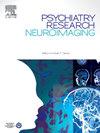Multiple dimensions approach in polysubstance use: An ESEM analysis based on the RDoC framework
IF 2.1
4区 医学
Q3 CLINICAL NEUROLOGY
引用次数: 0
Abstract
Substance use disorders (SUD) are associated with cognitive alterations, influenced by genetic, neurodevelopmental, and environmental factors, and frequently co-occur with emotional disorders, complicating treatment strategies. Employing the Research Domain Criteria (RDoC) framework and Exploratory Structural Equation Modeling (ESEM), this study investigated the direct and indirect relationships between drug abuse, neurocognitive performance, emotional indicators, and structural changes in brain regions implicated in emotional regulation and executive functions in SUD patients and healthy controls. High-resolution magnetic resonance imaging (MRI) scans were acquired from patients with SUD (n=50) and healthy controls (HC=50). Group differences were assessed using voxel-based morphometry (VBM) and regions of interest (ROIs). Participants were evaluated for substance use (ASSIST) and completed a battery of cognitive tasks and emotional tests. The SUD group exhibited higher levels of depression and anxiety, as well as cognitive deficits, compared to the control group. Additionally, the SUD group showed significantly lower gray matter volume (GMV) in cortical and limbic areas. However, the ESEM analysis indicated that limbic areas indirectly and negatively impacted ASSIST scores. Thus, we can conclude that structural impairments in limbic areas strongly influenced substance use patterns, even when reductions in cortical volume and impaired cognitive performance were also present.
多物质使用中的多维方法:基于RDoC框架的ESEM分析
物质使用障碍(SUD)与认知改变有关,受遗传、神经发育和环境因素的影响,并经常与情绪障碍共同发生,使治疗策略复杂化。本研究采用研究领域标准(RDoC)框架和探索性结构方程模型(ESEM),探讨了药物滥用、神经认知表现、情绪指标以及与情绪调节和执行功能相关的脑区结构变化在SUD患者和健康对照中的直接和间接关系。对50例SUD患者(n=50)和50例健康对照(HC=50)进行高分辨率磁共振成像(MRI)扫描。使用基于体素的形态测量(VBM)和感兴趣区域(roi)评估组间差异。研究人员对参与者进行了物质使用评估(ASSIST),并完成了一系列认知任务和情绪测试。与对照组相比,SUD组表现出更高水平的抑郁和焦虑,以及认知缺陷。此外,SUD组皮质和边缘区灰质体积(GMV)明显降低。然而,ESEM分析表明,边缘区域间接和负向影响ASSIST评分。因此,我们可以得出结论,即使在皮质体积减少和认知能力受损的情况下,边缘区域的结构损伤也会强烈影响物质使用模式。
本文章由计算机程序翻译,如有差异,请以英文原文为准。
求助全文
约1分钟内获得全文
求助全文
来源期刊
CiteScore
3.80
自引率
0.00%
发文量
86
审稿时长
22.5 weeks
期刊介绍:
The Neuroimaging section of Psychiatry Research publishes manuscripts on positron emission tomography, magnetic resonance imaging, computerized electroencephalographic topography, regional cerebral blood flow, computed tomography, magnetoencephalography, autoradiography, post-mortem regional analyses, and other imaging techniques. Reports concerning results in psychiatric disorders, dementias, and the effects of behaviorial tasks and pharmacological treatments are featured. We also invite manuscripts on the methods of obtaining images and computer processing of the images themselves. Selected case reports are also published.

 求助内容:
求助内容: 应助结果提醒方式:
应助结果提醒方式:


